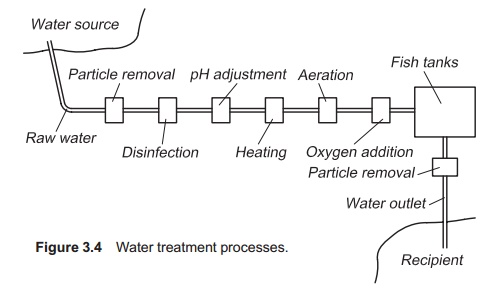Chapter: Aquaculture Engineering : Water Quality and Water Treatment: an Introduction
Water treatment in Aquaculture
Water treatment
All treatment of water leads to a change in the water
quality, and it is improvement that is wanted. Regardless of the incoming water
quality, it will always be possible to obtain a quality good enough for growing
aquaculture products. The problem is, however, the cost; all water treatment
operations involve expenditure. A major advantage for a good farming site is
therefore to have good quality incoming water with low treatment requirements.
Several processes may be needed to adjust the water
quality. The inlet water to land-based farms is aerated; pH adjustment and
particle removal are also required. Heating and chilling are normally used to
create optimal growth conditions. In some cases disinfection is needed to
reduce the burden of micro-organisms, especially in fry production (Fig. 3.4).

The outlet water from the fish farm may also be treated to
avoid affecting the water quality of therecipient water body. If the recipient
water body is highly eutrophicated the outlet water must be treated, and this
is also the case if there are valuable wild stocks in the receiving water.
Treatment of outlet water will, however, increase production costs, and is done
only when necessary. Often government regulations will dictate the level of treatment
required. Sites that require less water treatment are therefore favoured.
Treatment of the outlet water is normally restricted to
removal of part of the suspended solids. From a cost perspective, is it
normally impos-sible to remove dissolved substances such as nutri-ents and
small micro-organisms in a flow-through farm with relatively high fish
densities, because of the size of the water flow; if re-use systems are
employed, such treatments may be included. However, re-use systems have much
higher invest-ment costs than flow-through farms.
Treatment of outlet water will, however, increase
production costs, and is done only when necessary. Often government regulations
will dictate the level of treatment required. Sites that require less water
treatment are therefore favoured.
Treatment of the outlet water is normally restricted to
removal of part of the suspended solids. From a cost perspective, is it
normally impos-sible to remove dissolved substances such as nutrients and small
micro-organisms in a flow-through farm with relatively high fish densities,
because of the size of the water flow; if re-use systems are employed, such
treatments may be included. However, re-use systems have much higher
invest-ment costs than flow-through farms.
Related Topics